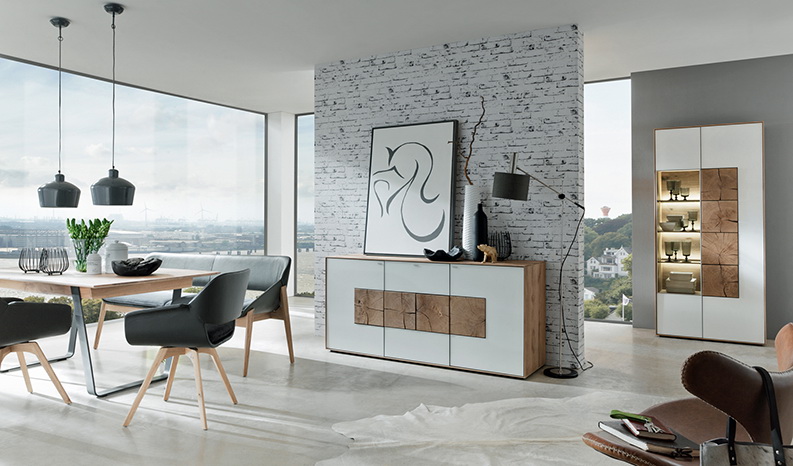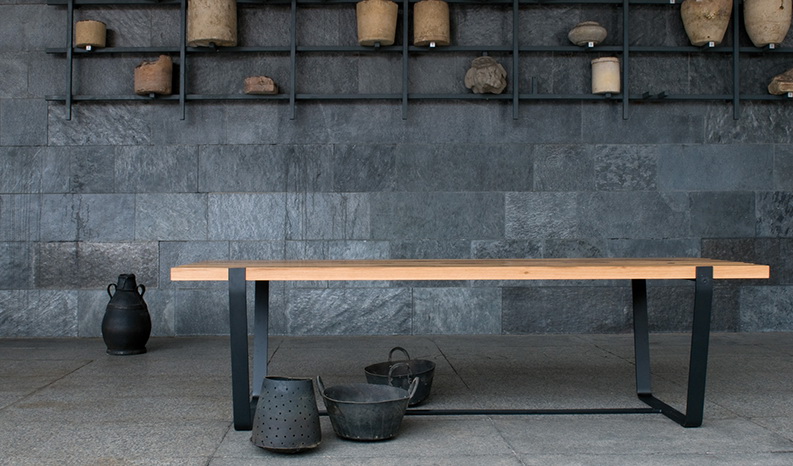Solid wood is extremely versatile, lending its strength to home building, floorings and furniture. It creates a natural indoor ambience and fuels the huge trend for individuality as each piece of solid wood is unique in its own right because every species of tree – and every tree, too – has a look that is entirely its own.
The unique visual effect of a piece of solid wood furniture is largely the result of its colour, structure and texture. Maple and birch are usually yellowy-white, very homogeneous and finely structured. Beech is slightly darker with a hint of red, but also finely structured. Oak, by contrast, has a rather more rustic appearance. Varying from light grey to reddish-brown, it gives a piece of furniture a less regular appearance with its colourful structure. Pine provides an internal contrast with its light, almost honey-coloured tone and its mostly dark grain. Walnut is especially interesting for furniture making. Black-brown in parts with a cloud-like structure, it has a subtle yet intriguing grain.

© HDH
But differences not only exist between the individual species: even within a species, there can be considerable variations. The climate and soil composition that trees are exposed to in different locations can play a role, for instance. American walnut is darker than European walnut and has a slightly more homogeneous grain. But the effect of light on furniture can also alter the colour of the wood. Acacia, for example, has a light brown tone to begin with, but it can darken into a decorative golden brown as the wood ages. A tree’s sapwood also often looks different to its heartwood. The outer sapwood is younger and often lighter in colour than the heartwood at its core, a contrast that is especially pronounced in pine.

© IPM, Hartmann
Beech heartwood is something quite different. Here “heartwood” simply refers to discolourations similar to heartwood or structural characteristics such as knots or fissures known as heart shakes. Timber with intergrown knots, a prominent grain pattern and a wide, natural spectrum of colours is often described as “wild” by furniture makers. Wild oak, wild walnut and wild beech are not real species, but merely labels used in the furniture industry, just like beech heartwood.

© IPM, Hartmann
Anyone who chooses solid wood furniture is buying more than just the structure and texture that nature has given it. They are choosing sustainability. Solid wood furniture is easy to restore when the first signs of use start to show. Depending on its characteristics, the surface can easily be given a new lease of life with furniture polish or wax – and any dents or scratches are easy to remove with sandpaper or a damp cotton cloth and an iron. Simply place a damp cloth over the dent, and carefully steam with an iron on a low setting. This causes the fibres that have been pressed inwards to stand up again, and the dent disappears.

© Mirjam Fruscella_Koelnmesse, Janua
In addition to solid wood’s longevity, conserving resources is another consideration: wood is a renewable raw material and largely produced in sustainably managed forests. What’s more, the climate-damaging CO2 absorbed during the tree’s lifetime remains stored in the furniture after it is processed. And even better: its open-pored surface means that solid wood acts as an air filter, absorbing pollutants in the home even after it has been made into furniture. Wood can also absorb or release moisture depending on the ambient temperature. If the ambient humidity is high, it reabsorbs the moisture, which has a positive effect on the indoor climate.
